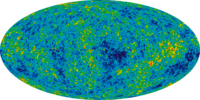
Photo from wikipedia
The LUX experiment has performed searches for dark-matter particles scattering elastically on xenon nuclei, leading to stringent upper limits on the nuclear scattering cross sections for dark matter. Here, for… Click to show full abstract
The LUX experiment has performed searches for dark-matter particles scattering elastically on xenon nuclei, leading to stringent upper limits on the nuclear scattering cross sections for dark matter. Here, for results derived from 1.4×104 kg days of target exposure in 2013, details of the calibration, event-reconstruction, modeling, and statistical tests that underlie the results are presented. Detector performance is characterized, including measured efficiencies, stability of response, position resolution, and discrimination between electron- and nuclear-recoil populations. Models are developed for the drift field, optical properties, background populations, the electron- and nuclear-recoil responses, and the absolute rate of low-energy background events. Innovations in the analysis include in situ measurement of the photomultipliers' response to xenon scintillation photons, verification of fiducial mass with a low-energy internal calibration source, and new empirical models for low-energy signal yield based on large-sample, in situ calibrations.
Journal Title: Physical Review D
Year Published: 2018
Link to full text (if available)
Share on Social Media: Sign Up to like & get
recommendations!